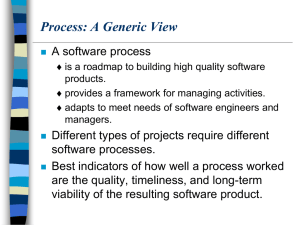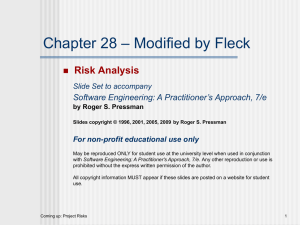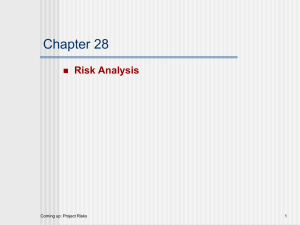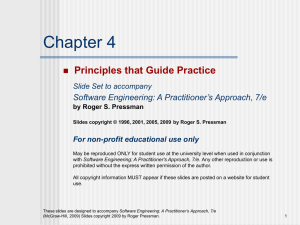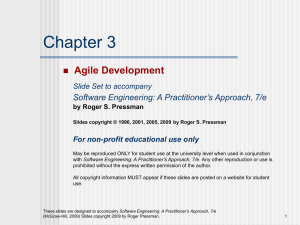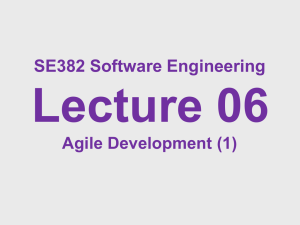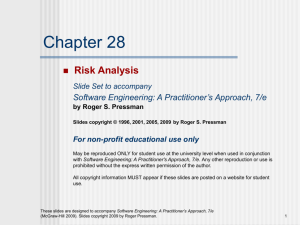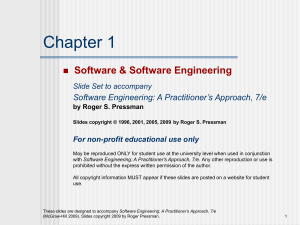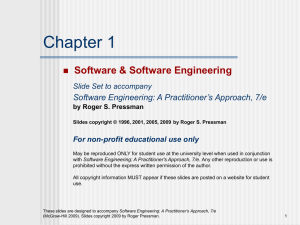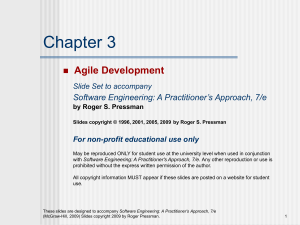Chapter 1 What is Software? - Software Engineering @ RIT
advertisement
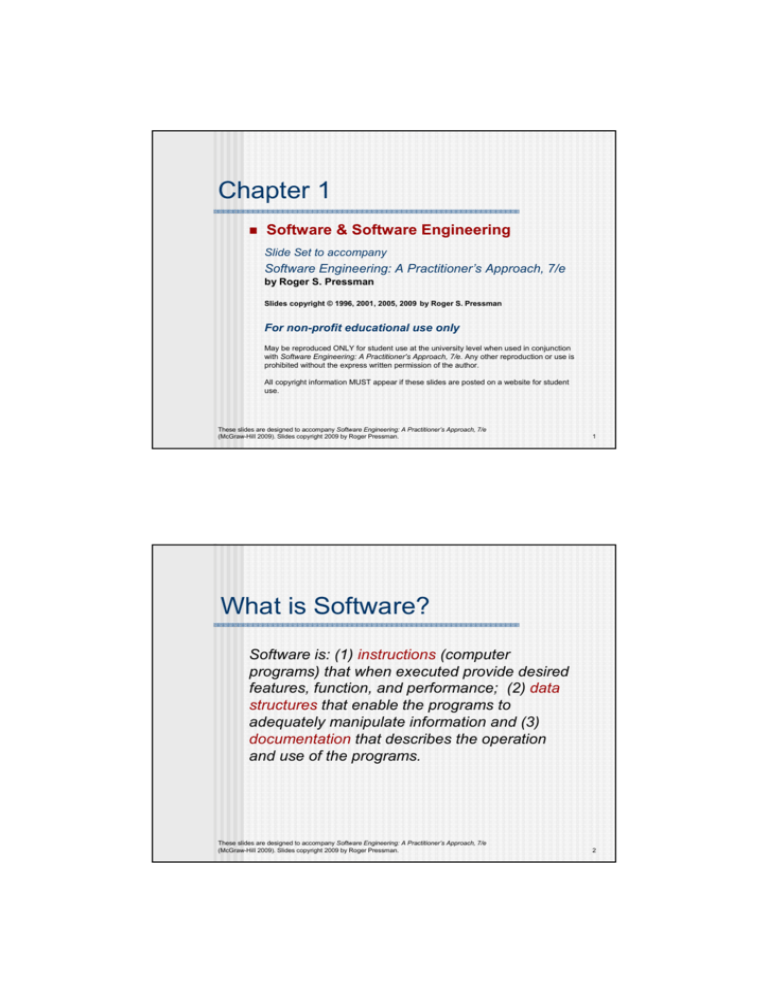
Chapter 1 Software & Software Engineering Slide Set to accompany Software Engineering: A Practitioner’s Approach, 7/e by Roger S. Pressman Slides copyright © 1996, 2001, 2005, 2009 by Roger S. Pressman For non-profit educational use only May be reproduced ONLY for student use at the university level when used in conjunction with Software Engineering: A Practitioner's Approach, 7/e. Any other reproduction or use is prohibited without the express written permission of the author. All copyright information MUST appear if these slides are posted on a website for student use. These slides are designed to accompany Software Engineering: A Practitioner’s Approach, 7/e (McGraw-Hill 2009). Slides copyright 2009 by Roger Pressman. 1 What is Software? Software is: (1) instructions (computer programs) that when executed provide desired features, function, and performance; (2) data structures that enable the programs to adequately manipulate information and (3) documentation that describes the operation and use of the programs. These slides are designed to accompany Software Engineering: A Practitioner’s Approach, 7/e (McGraw-Hill 2009). Slides copyright 2009 by Roger Pressman. 2 What is Software? Software is developed or engineered, it is not manufactured in the classical sense. Software doesn't "wear out." Although the industry is moving toward component-based construction, most software continues to be custom-built. These slides are designed to accompany Software Engineering: A Practitioner’s Approach, 7/e (McGraw-Hill 2009). Slides copyright 2009 by Roger Pressman. 3 Wear vs. Deterioration increased failure rate due to side effects Failure rate change actual curve idealized curve Time These slides are designed to accompany Software Engineering: A Practitioner’s Approach, 7/e (McGraw-Hill 2009). Slides copyright 2009 by Roger Pressman. 4 Software Applications system software application software engineering/scientific software embedded software product-line software WebApps (Web applications) AI software These slides are designed to accompany Software Engineering: A Practitioner’s Approach, 7/e (McGraw-Hill 2009). Slides copyright 2009 by Roger Pressman. 5 Software—New Categories Open world computing—pervasive, distributed computing Ubiquitous computing—wireless networks Netsourcing—the Web as a computing engine Open source—”free” source code open to the computing community (a blessing, but also a potential curse!) These slides are designed to accompany Software Engineering: A Practitioner’s Approach, 7/e (McGraw-Hill 2009). Slides copyright 2009 by Roger Pressman. 6 Legacy Software Why must it change? software must be adapted to meet the needs of new computing environments or technology. software must be enhanced to implement new business requirements. software must be extended to make it interoperable with other more modern systems or databases. software must be re-architected to make it viable within a network environment. These slides are designed to accompany Software Engineering: A Practitioner’s Approach, 7/e (McGraw-Hill 2009). Slides copyright 2009 by Roger Pressman. 7 Software Engineering Some realities: a concerted effort should be made to understand the problem before a software solution is developed design becomes a pivotal activity software should exhibit high quality software should be maintainable The seminal definition: [Software engineering is] the establishment and use of sound engineering principles in order to obtain economically software that is reliable and works efficiently on real machines. These slides are designed to accompany Software Engineering: A Practitioner’s Approach, 7/e (McGraw-Hill 2009). Slides copyright 2009 by Roger Pressman. 8 Software Engineering The IEEE definition: Software Engineering: (1) The application of a systematic, disciplined, quantifiable approach to the development, operation, and maintenance of software; that is, the application of engineering to software. (2) The study of approaches as in (1). These slides are designed to accompany Software Engineering: A Practitioner’s Approach, 7/e (McGraw-Hill 2009). Slides copyright 2009 by Roger Pressman. 9 A Layered Technology tools methods process model a “quality” quality” focus Software Engineering These slides are designed to accompany Software Engineering: A Practitioner’s Approach, 7/e (McGraw-Hill 2009). Slides copyright 2009 by Roger Pressman. 10 A Process Framework Process framework Framework activities work tasks work products milestones & deliverables QA checkpoints Umbrella Activities These slides are designed to accompany Software Engineering: A Practitioner’s Approach, 7/e (McGraw-Hill 2009). Slides copyright 2009 by Roger Pressman. 11 Framework Activities Communication Planning Modeling Construction Analysis of requirements Design Code generation Testing Deployment These slides are designed to accompany Software Engineering: A Practitioner’s Approach, 7/e (McGraw-Hill 2009). Slides copyright 2009 by Roger Pressman. 12 Umbrella Activities Software project management Formal technical reviews Software quality assurance Software configuration management Work product preparation and production Reusability management Measurement Risk management These slides are designed to accompany Software Engineering: A Practitioner’s Approach, 7/e (McGraw-Hill 2009). Slides copyright 2009 by Roger Pressman. 13 The Essence of Practice Polya suggests: 1. Understand the problem (communication and analysis). 2. Plan a solution (modeling and software design). 3. Carry out the plan (code generation). 4. Examine the result for accuracy (testing and quality assurance). These slides are designed to accompany Software Engineering: A Practitioner’s Approach, 7/e (McGraw-Hill 2009). Slides copyright 2009 by Roger Pressman. 14 Understand the Problem Who has a stake in the solution to the problem? That is, who are the stakeholders? What are the unknowns? What data, functions, and features are required to properly solve the problem? Can the problem be compartmentalized? Is it possible to represent smaller problems that may be easier to understand? Can the problem be represented graphically? Can an analysis model be created? These slides are designed to accompany Software Engineering: A Practitioner’s Approach, 7/e (McGraw-Hill 2009). Slides copyright 2009 by Roger Pressman. 15 Plan the Solution Have you seen similar problems before? Are there patterns that are recognizable in a potential solution? Is there existing software that implements the data, functions, and features that are required? Has a similar problem been solved? If so, are elements of the solution reusable? Can subproblems be defined? If so, are solutions readily apparent for the subproblems? Can you represent a solution in a manner that leads to effective implementation? Can a design model be created? These slides are designed to accompany Software Engineering: A Practitioner’s Approach, 7/e (McGraw-Hill 2009). Slides copyright 2009 by Roger Pressman. 16 Carry Out the Plan Does the solution conform to the plan? Is source code traceable to the design model? Is each component part of the solution provably correct? Has the design and code been reviewed, or better, have correctness proofs been applied to algorithm? These slides are designed to accompany Software Engineering: A Practitioner’s Approach, 7/e (McGraw-Hill 2009). Slides copyright 2009 by Roger Pressman. 17 Examine the Result Is it possible to test each component part of the solution? Has a reasonable testing strategy been implemented? Does the solution produce results that conform to the data, functions, and features that are required? Has the software been validated against all stakeholder requirements? These slides are designed to accompany Software Engineering: A Practitioner’s Approach, 7/e (McGraw-Hill 2009). Slides copyright 2009 by Roger Pressman. 18 Software Myths Affect managers, customers (and other non-technical stakeholders) and practitioners Are believable because they often have elements of truth, but … Invariably lead to bad decisions, therefore … Insist on reality as you navigate your way through software engineering These slides are designed to accompany Software Engineering: A Practitioner’s Approach, 7/e (McGraw-Hill 2009). Slides copyright 2009 by Roger Pressman. 19
